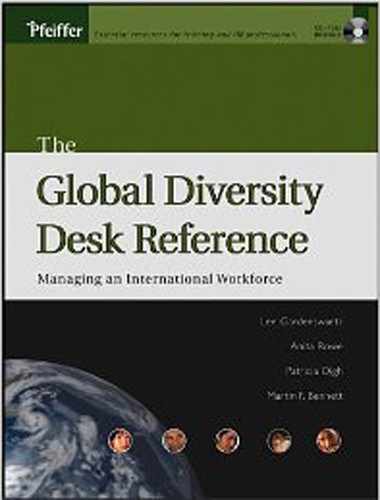1.10. DEVELOPING INTERCULTURAL SENSITIVITY
Like most change processes, understanding culture is an ongoing and incremental process. Interculturalist Milton Bennett developed a model that helps us understand the stages that individuals—and organizations—go through in reconciling cultural difference. To explain the process, Bennett developed the Developmental Model of Intercultural Sensitivity (DMIS), articulating six Stages of Intercultural Sensitivity, shown in the model and described below.
The first three phases are ethnocentric. In these phases people unconsciously experience their own culture as central to reality. At the other end of the scale is ethnorelativism, a successful blending of more than one culture. People often move subconsciously through these stages as their international and intercultural experiences grow. As you engage in global diversity work in your organization using the tools from this book, you will observe individuals in each of these stages.
Ethnocentric Stages
Denial of Difference. In this stage, there is no recognition of cultural difference because individuals isolate themselves or intentionally separate from those who are different. The "other" is often thought to be deficient intellectually or to demonstrate culturally deviant behavior. In this stage, we tend to dehumanize outsiders.

Defense Against Difference. In this stage, we recognize cultural difference, but couple that recognition with a negative evaluation of most variations from our native culture–the greater the difference, the more negative the evaluation. We tend to view cultural development as evolutionary, with our own culture as the pinnacle of that evolutionary process. In this stage, there is also a tendency toward the social or cultural proselytizing of "underdeveloped" cultures.
Reversal. In this stage, we tend to see another culture as superior while maligning our own.
Minimization of Difference. Here we recognize and accept superficial cultural differences, such as eating customs, while maintaining that all human beings are essentially the same. The emphasis in this stage is on the similarity of people and the commonality of basic values. Our tendency is to define the basis of commonality in ethnocentric terms (that is, everyone is essentially like us).
Physical Universalism. In this stage, people tend to emphasize the commonality of human beings in terms of physiological similarity.
Transcendent Universalism. In this stage, we emphasize the commonality of human beings as subordinate to a particular supernatural being, religion, or social philosophy.
Ethnorelative Stages
Acceptance of Difference. Here we recognize and appreciate cultural difference in behavior and values. We accept cultural differences as viable alternative solutions to the organization of human existence. Cultural relativity marks this stage.
Adaptation of Difference. In this stage, we begin to develop communication skills that enable intercultural communication. Hallmarks include effective use of empathy or shifting our frame of reference to understand and be understood across cultural boundaries.
Integration of Difference. In this stage, we internalize bicultural or multicultural frames of reference. We are able to maintain a definition of identity that is "marginal" to any particular culture.[]
Bennett's model helps us understand that even those people in our organizations who resist global diversity work are moving from the model's first stage of intercultural sensitivity—denial (failure to recognize that cultural differences exist)—into the second stage, defense (recognition of differences).
